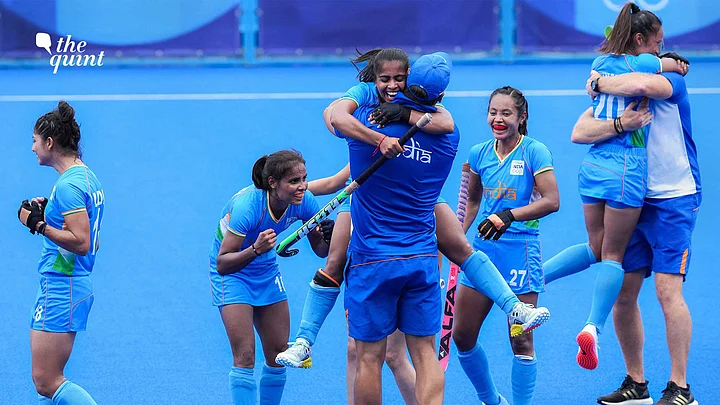Many may have run the risk of dismissing India’s win as a daydream had it not been for the tears that flowed. The teardrops were a confirmation of the beautiful reality — that the Indian women’s hockey team pulled a rabbit out of a hat, with a 1-0 victory over the formidable Australia, to enter the semifinals of the Tokyo Olympics 2020.
To say that India waited for such a day to dawn would be to believe that was an ounce of expectation. It is the kind that happens without a warning, without a notice. It is the kind of day that India must soak in, drench itself in the raw surge of emotions that such a result on the grandest stage can conjure.
Beyond the palest shadow of doubt, this is the greatest moment in Indian women’s hockey history. And it will certainly rank among the top 10 Olympic moments for India since independence. It takes that place with pride at its root and on the back of a performance that was an incredible combination of mind and heart.
Emotional Moment for Team India
The strength of the mind was evident throughout the match but perhaps the most during the second half when Australia tried everything it could to find a goal. The manner in which the defence held its nerves was truly wonderful. The role of the heart was reflected in the manner in which the players had one another’s back, coming together to string a team show.
“I don't know what to say because emotions are too high at the moment, and we all are very happy because it was not an easy game to win from Australia,” said captain Rani Rampal. “But I'm super proud of my team; each one really worked hard throughout the game. And we just said one thing to each other, 'Just believe in ourselves, we can do this well'.”
As a team whose predecessor in the 2016 Games did not secure a single victory, India had done well to rise to a high of ninth on the FIH World Rankings. And few gave India the chance of making it to the quarterfinals. And yet, assisted by a good support system, it is now within one victory of an Olympic medal. Their story is what dreams are made of.
Sticking Together as Family
Coach Sjoerd Marijne plays one of the most signicant roles for the team. He took over from Roelant Oltmans as the coach of the men’s team in 2017 but lasted only a few months in that role. In a wise move, Hockey India opted to not let him go but re-assigned him to the women’s team.
The stability that Marijne has brought to the squad helped immensely. When players become aware that chopping and changing do not happen on a whim, they take greater responsibility for their own work. Besides, Wayne Lombard’s fitness regimen has ensured that this Indian team turned out to be the fittest team India's ever seen.
The pandemic helped in keeping the family together.
Family, did you say?
Perhaps they were bound by the fact that many of them started their careers in Sports Authority of India facilities in the country, ranging from Hisar (Savita and Udita), Sundargarh (Deep Grace Ekka), Bhopal (Vandana Kataria), Ranchi (Nikki), Thenzwal, and Aizwal (Lalremsiami).
They have similar socio-economic backgrounds, many of them who have hockey as a means to reduce the financial burden on their respective families. Without the pressure of a massive legacy in Olympic Games – it is only the third time an Indian women’s team is competing in an Olympic competition – they have all looked to deliver something special. For one another.
Determined Team Stand Up and Get Counted
Besides, the team drew benefits of being together for long spells in SAI Bengaluru during the lockdown, forced by the COVID-19 outbreak and later. In the recent weeks, there was some worry about COVID-19 infection that some players grappled with, but all seems well as the side rallied from three defeats in the group to beat Ireland and South Africa.
Even then, who would have imagined the mighty Australia bowing out of the Olympic Games quarterfinals, unable to make capital of nine penalty corners? Who would have imagined India closing the door on Australia with one magical penalty corner strike by Gurjit Kaur, who slotted the ball home through a maze of legs and hockey sticks.
It was only the second time in the Olympic Games that the Australian citadel was breached. Beatriz Perez Lagunas had scored a goal for Spain. The Hockeyroos kept a clean slate for 289 minutes after that until Gurjit Kaur scored on Monday, 2 August. The irony would not have been lost on Australia. Until that moment, India had a penalty corner conversion percentage of 12.5.
For Australia, it did not seem to matter that its own penalty corner conversion was an abysmal 5.2 percent, as it was able to find the field goals almost at will, scoring as many as 11 of them in the five league games. On Monday, however, Australia was up against the resolute Indian defence, playing with great heart, anticipating well and denying the marauding rival admirably.
With Savita and the defence line led by Deep Grace Ekka standing tall against everything that the Australians managed, the heart rose to the mouth while waiting for the countdown timer to hurry to 00:00. In one corner of the screen, the clock was ticking down in slow motion. And elsewhere, the Australians were swarming the Indian half in search of that elusive goal.
And then, when the hooter sounded to mark a famous Indian win, one that will be etched in the minds of all those who watched it, images of the bunch of believers huddling together in celebration streamed into Indian homes or through mobile devices. It was signal for many a tear-sac to uncork itself.
